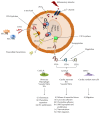Role of the Cysteinyl Leukotrienes in the Pathogenesis and Progression of Cardiovascular Diseases
- PMID: 28932020
- PMCID: PMC5592403
- DOI: 10.1155/2017/2432958
Role of the Cysteinyl Leukotrienes in the Pathogenesis and Progression of Cardiovascular Diseases
Abstract
Cysteinyl leukotrienes (CysLTs) are potent lipid inflammatory mediators synthesized from arachidonic acid, through the 5-lipoxygenase (5-LO) pathway. Owing to their properties, CysLTs play a crucial role in the pathogenesis of inflammation; therefore, CysLT modifiers as synthesis inhibitors or receptor antagonists, central in asthma management, may become a potential target for the treatment of other inflammatory diseases such as the cardiovascular disorders. 5-LO pathway activation and increased expression of its mediators and receptors are found in cardiovascular diseases. Moreover, the cardioprotective effects observed by using CysLT modifiers are promising and contribute to elucidate the link between CysLTs and cardiovascular disease. The aim of this review is to summarize the state of present research about the role of the CysLTs in the pathogenesis and progression of atherosclerosis and myocardial infarction.
Figures


Similar articles
-
The role of leukotrienes in allergic diseases.Allergol Int. 2015 Jan;64(1):17-26. doi: 10.1016/j.alit.2014.09.001. Epub 2014 Nov 22. Allergol Int. 2015. PMID: 25572555 Review.
-
Cysteinyl leukotrienes and their receptors: molecular and functional characteristics.Pharmacology. 2010;85(6):336-49. doi: 10.1159/000312669. Epub 2010 Jun 2. Pharmacology. 2010. PMID: 20516735 Review.
-
The role of leukotrienes in the pathophysiology of inflammatory disorders: is there a case for revisiting leukotrienes as therapeutic targets?Inflammopharmacology. 2006 Mar;14(1-2):10-6. doi: 10.1007/s10787-006-1496-6. Inflammopharmacology. 2006. PMID: 16835707 Review.
-
A novel therapeutic potential of cysteinyl leukotrienes and their receptors modulation in the neurological complications associated with Alzheimer's disease.Eur J Pharmacol. 2019 Jan 5;842:208-220. doi: 10.1016/j.ejphar.2018.10.040. Epub 2018 Oct 30. Eur J Pharmacol. 2019. PMID: 30389631 Review.
-
Cysteinyl-leukotriene pathway as a new therapeutic target for the treatment of atherosclerosis related to obstructive sleep apnea syndrome.Pharmacol Res. 2018 Aug;134:311-319. doi: 10.1016/j.phrs.2018.06.014. Epub 2018 Jun 18. Pharmacol Res. 2018. PMID: 29920371
Cited by
-
Montelukast and Acute Coronary Syndrome: The Endowed Drug.Pharmaceuticals (Basel). 2022 Sep 14;15(9):1147. doi: 10.3390/ph15091147. Pharmaceuticals (Basel). 2022. PMID: 36145367 Free PMC article. Review.
-
Allergic asthma is a risk factor for human cardiovascular diseases.Nat Cardiovasc Res. 2022 May;1(5):417-430. doi: 10.1038/s44161-022-00067-z. Epub 2022 May 16. Nat Cardiovasc Res. 2022. PMID: 39195946 Review.
-
Eicosanoids in inflammation in the blood and the vessel.Front Pharmacol. 2022 Sep 27;13:997403. doi: 10.3389/fphar.2022.997403. eCollection 2022. Front Pharmacol. 2022. PMID: 36238558 Free PMC article. Review.
-
Fatty Acid Levels and Their Inflammatory Metabolites Are Associated with the Nondipping Status and Risk of Obstructive Sleep Apnea Syndrome in Stroke Patients.Biomedicines. 2022 Sep 6;10(9):2200. doi: 10.3390/biomedicines10092200. Biomedicines. 2022. PMID: 36140306 Free PMC article.
-
Polydatin Reduces Cardiotoxicity and Enhances the Anticancer Effects of Sunitinib by Decreasing Pro-Oxidative Stress, Pro-Inflammatory Cytokines, and NLRP3 Inflammasome Expression.Front Oncol. 2021 Jun 11;11:680758. doi: 10.3389/fonc.2021.680758. eCollection 2021. Front Oncol. 2021. PMID: 34178667 Free PMC article.
References
Publication types
MeSH terms
Substances
LinkOut - more resources
Full Text Sources
Other Literature Sources

